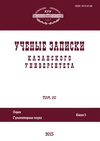ИЗДАНИЕ УЧЕБНОЙ ЛИТЕРАТУРЫ ПРЕДСТАВИТЕЛЯМИ ТЮРКО-ТАТАРСКОЙ ЭМИГРАЦИИ НА ДАЛЬНЕМ ВОСТОКЕ В 30–40-е ГОДЫ XX ВЕКA
THE PUBLICATION OF EDUCATIONAL LITERATURE DURING THE 1930S–1940S BY THE TURKIC-TATAR EMIGRE REPRESENTATIVES IN THE FAR EAST
Author(s): Diliara M. UsmanovaSubject(s): History of Education, Interwar Period (1920 - 1939), WW II and following years (1940 - 1949), Theory of Literature
Published by: Казанский (Приволжский) федеральный университет
Keywords: Turkic-Tatar emigre communities; Tokyo; Hailar; Mukden; educational literature; Muhammad- Gabdulkhay Kurbangaliev; Ahmet Hadi Maksudi; Mukhitdin Kurbangaliev; Galimjan Ibrahimov;
Summary/Abstract: The paper discusses the situation with textbooks and educational literature published by representatives of the Turkic-Tatar emigre communities in the Far East during the 1930s–1940s. They were meant for the needs of Tatar primary schools (4–6 years) that functioned during the second quarter of the 20th century in most cities of Manchuria and Japan (Tokyo, Nagoya, Mukden, Harbin, Hailar, etc.) and were dominated by the humanitarian and Tatar cultural component. At the same time, due to the small number of communities, as well as the lack of technical base and material resources, separate textbooks on the Tatar language, Tatar history, and the basics of arithmetic operations created during the prerevolutionary period were published and popular among the population. Thus, the Turkic-speaking émigré communities, for a number of reasons, could not create a new original content and published only what was in the pre-revolutionary educational and pedagogical legacy. Interestingly, these factors helped to preserve the continuity of generations for the new Turkic-Tatar emigre population and contributed to their inclusion in the general Tatar cultural context. It was also facilitated by the fact that the Far Eastern Tatar emigre communities used the Arabic script as the basis of the Tatar written tradition for the longest period of time (at least until the late 1940s – early 1950s).
Journal: Ученые записки Казанского университета. Серия Гуманитарные науки
- Issue Year: 161/2019
- Issue No: 2-3
- Page Range: 188-198
- Page Count: 11
- Language: Russian

